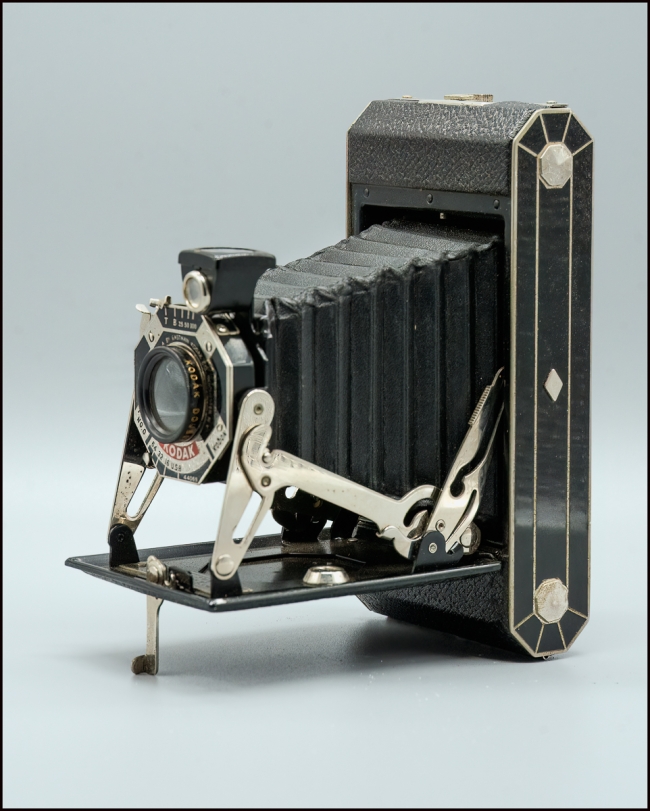With the acquisition of this camera I’ve broken two of my rules for collecting cameras.
The first is that I would not acquire a camera that I could not or would not use. I’ve on occasion acquired a camera that was supposed to be working, but turned out to be non-functional. However, I’ve never bought a camera that I knew I wouldn’t use. I think it’s unlikely (but not impossible) that I will use this one. Although you never really know until you try to use it, I believe this camera works. Unfortunately, the film (620 film) was discontinued in 1995. Although the actual film is the same as 120 film (which is still available), the spools are different. The 620 spools are slightly shorter and have a smaller diameter. It is possible to cut down a spool of 120 film to fit or to re-spool some 120 film onto 620 spools in a darkroom or changing bag. Some people do this and sell the result, so it is still possible to get this film. However, it’s difficult to find and expensive. More important, I’ve read that the camera takes terrible pictures. I’m might get my hands on a roll of 620 film and try it out, or because of the apparently poor quality of the images I might not bother. I haven’t decided yet.
Second, I had long ago decided not to collect Kodak Folding Cameras. While they certainly have their charm I was afraid of going down that particular rabbit hole in case I couldn’t make my way out.
So why then did I acquire this camera? The reason is that I’ve decided to start collecting bakelite and art-deco cameras. This one is an excellent example of the latter. Unfortunately, these cameras tend to be old and use film that is difficult (and in many cases impossible) to obtain. Most of them look great though.
I’ve found a great site: Art Deco Cameras, which has a wealth of information on such cameras and how to use them. I imagine it will become my guide to finding addition leads.
This one is a Kodak Six-20 and according to Art Deco Cameras:
The Six-20 Kodak was introduced in 1932 but from 1933 it was redesigned to become the Six-20 model C. It is a self-erecting folding camera. It has angled ends to the body which is covered with pig-grained leatherette. It has a brilliant finders that swivels to cater for both portrait and landscape views. It does not have a folding frame finder. It features black enameled side panels with nickel lines. The shutter plate is octagonal with chrome and black enamel deco pattern as well as bright red highlights. It has a swiveling red window cover. The struts are chrome and ornate unlike the redesigned Model C which are quite plain.
It supported two combinations of lens and shutter. These are a Doublet lens coupled with Kodon shutter or a Kodak Anastigmat f/6.3 with a Kodon shutter.
I believe mine is the former i.e. the one with the doublet lens, which is a pity because if I did choose to use it I’m sure the latter would produce better images.
Art Deco Cameras also rates the cameras as to the extent to which they have the characteristics of an art-deco Camera and describes this camera as follows:
Iconic: Famous, well-known and celebrated
- Produced during the main Art Deco period.
- Octagonal face plate design with red highlights.
- Ornate chrome struts.
- Angled ends to body.
- Enameled side panels with nickel lines.
- Raised diamond and octagonal motifs
- Pig-grained leatherette
- Octagonal film winder
- Chrome and black enamel brilliant finder
Taken with a Sony A7IV and Venus Optics Laowa 85mm f5.6

